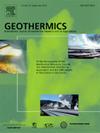Exploring geothermal potential with robust satellite techniques using MODIS LST data
IF 3.5
2区 工程技术
Q3 ENERGY & FUELS
引用次数: 0
Abstract
Thermal infrared remote sensing is an emerging technique for detecting geothermal anomalies in volcanically and tectonically active regions. This study evaluates its applicability for geothermal prospecting and thermal activity monitoring in southwestern Yunnan, China-a remote frontier characterized by dense vegetation and complex terrain. Despite its considerable geothermal potential, the region remains underexplored due to limited accessibility and the lack of long-term thermal monitoring. We applied Robust Satellite Techniques (RST) to 21 years (2003-2023) of MODIS nighttime Land Surface Temperature (LST) imagery. Thermal anomalies were extracted using the RETIRA index (threshold ≥ 4) with a cumulative frequency cutoff of ≥ 30. Anomalies were most prominent at intersections of active faults, with the most favorable geothermal zones occurring where anomalies coincided with mapped fault structures. A distinct W-shaped anomaly belt, consistent with previous surveys, was delineated in the Lianghe-Tengchong region. Of 61 known geothermal sites, 38 (∼63%) were detected using LST anomalies alone; this increased to 84% when fault data were incorporated. In Yingjiang County, anomalies aligned with historical seismic swarms, while in Longling, they corresponded with both earthquakes and hot springs, suggesting a fault-thermal-seismic relationship. Although hydrothermal alteration zones showed only partial spatial overlap with thermal anomalies, they further support the role of faults in facilitating subsurface heat transport. These findings demonstrate that RST, when applied to long-term MODIS LST data, provides an effective and scalable approach for geothermal exploration in tectonically active and data-scarce regions.
利用MODIS地表温度数据,利用强大的卫星技术探索地热潜力
热红外遥感是一种新兴的探测火山和构造活动区地热异常的技术。本研究评价了该方法在滇西南地区地热勘探和热活动监测中的适用性。滇西南地区地处偏远,植被茂密,地形复杂。尽管该地区地热潜力巨大,但由于可达性有限和缺乏长期热监测,该地区仍未得到充分开发。采用鲁棒卫星技术(Robust Satellite Techniques, RST)对2003-2023年MODIS夜间地表温度(LST)影像进行分析。利用RETIRA指数(阈值≥4)提取热异常,累积频率截止值≥30。异常在活动断裂的交叉处最为突出,最有利的地热带出现在异常与绘制的断裂结构重合的地方。在两河-腾冲地区圈定了一条明显的w型异常带,与以往的勘探结果一致。在61个已知的地热点中,38个(约63%)仅使用地表温度异常进行探测;当纳入故障数据时,这一比例增加到84%。盈江县异常与历史地震群一致,龙陵县异常与地震和温泉同时对应,提示断层-热-地震关系。虽然热液蚀变带与热异常仅表现出部分空间重叠,但它们进一步支持断层在促进地下热输运中的作用。这些发现表明,当RST应用于MODIS长期LST数据时,为构造活跃和数据稀缺地区的地热勘探提供了一种有效且可扩展的方法。
本文章由计算机程序翻译,如有差异,请以英文原文为准。
求助全文
约1分钟内获得全文
求助全文
来源期刊

Geothermics
工程技术-地球科学综合
CiteScore
7.70
自引率
15.40%
发文量
237
审稿时长
4.5 months
期刊介绍:
Geothermics is an international journal devoted to the research and development of geothermal energy. The International Board of Editors of Geothermics, which comprises specialists in the various aspects of geothermal resources, exploration and development, guarantees the balanced, comprehensive view of scientific and technological developments in this promising energy field.
It promulgates the state of the art and science of geothermal energy, its exploration and exploitation through a regular exchange of information from all parts of the world. The journal publishes articles dealing with the theory, exploration techniques and all aspects of the utilization of geothermal resources. Geothermics serves as the scientific house, or exchange medium, through which the growing community of geothermal specialists can provide and receive information.
 求助内容:
求助内容: 应助结果提醒方式:
应助结果提醒方式:


